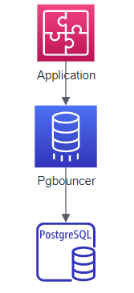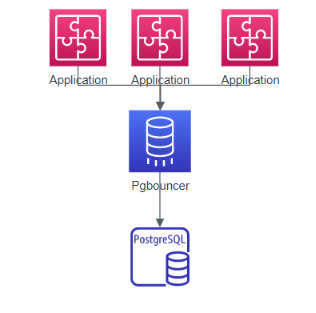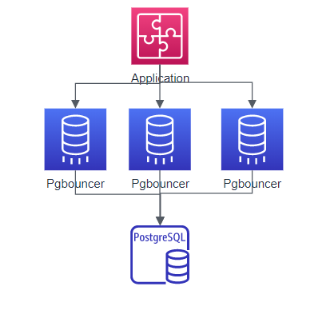Pgbouncer 最佳实践:系列四
作者:王志斌,曾获得中国 PostgreSQL 数据库管理工程师(PGCE),是 PostgreSQL 官方认证讲师,盘古云课堂特邀金牌讲师。
最后再来说一下关于 Pgbouncer 的部署形式,包括单应用场景、多应用场景、集群场景还有多实例场景,这些方式都是依据不同的业务场景,没有孰优孰劣,符合的才是对的。其中单应用和多应用场景来源于官方。
单应用场景:

单应用场景主要具体为短连接较多的场景,频繁进行数据库的连接操作,但操作时间较短,均为短连接,所以将 pgbouncer 于应用服务器部署在同一台服务器,减少应用服务器和 pgbouncer 之间的开销。
配置文件
[databases]
test1 =
test =
[pgbouncer]
listen_port = 6688
listen_addr = 192.168.165.3
auth_type = md5
auth_file = /home/postgres/pgbouncer/bin/userlist.txt
logfile = /home/postgres/pgbouncer/pgbouncer1.log
pidfile =/home/postgres/pgbouncer/pgbouncer1.pid
unixsocketdir = /tmp
;;unixsocketmode = 0777
admin_users = wzb
stats_users = wzb
pool_mode = session
maxclientconn=1000
defaultpoolsize=30
导出数据库中用户名及密码到 userslist.txt
userslist.txt,格式为用户名 密码
"testuser" "md54d15115d8bebd3188c1ae09c4a9848af"
"testuser1" "md5f8386abbae413786661ee5a5cfb5593c"
"wzb" "md53d57c4bc9a647385e6916efd0b44db46"
启动 Pgbouncer
pgbouncer -d pgbouncer.ini
客户端连接方式
psql -dtest1 -Utestuser1 -p6688
多应用场景:

多应用场景,一般指多个应用服务器连接数据库,因此可以选择将 pgbouncer 与数据库服务部署在同一台服务器上,减少 pgbouncer 和数据库之间的开销。
配置 PgBouncer.ini 文件
[databases]
a1 = host=127.0.0.1 port=5432 dbname=test
a2 = host=127.0.0.1 port=5432 dbname=test1
[pgbouncer]
listen_port = 6688
listen_addr = *
auth_type = md5
auth_file = /home/postgres/pgbouncer/bin/userlist.txt
logfile = /home/postgres/pgbouncer/pgbouncer.log
pidfile =/home/postgres/pgbouncer/pgbouncer.pid
admin_users = wzb
stats_users = wzb
pool_mode = session
maxclientconn=1000
defaultpoolsize=30
导出数据库中用户名及密码到 userslist.txt
userslist.txt,格式为用户名 密码
"testuser" "md54d15115d8bebd3188c1ae09c4a9848af"
"testuser1" "md5f8386abbae413786661ee5a5cfb5593c"
"wzb" "md53d57c4bc9a647385e6916efd0b44db46"
启动 Pgbouncer
pgbouncer -d pgbouncer.ini
连接后端数据库
$ psql -p 6688 -U testuser a1
$ psql -p 6688 -U testuser1 a2
连接 pgbouncer 数据库
psql -p 6688 pgbouncer -U wzb
pgbouncer=# show help;
NOTICE: Console usage
DETAIL:
SHOW HELP|CONFIG|DATABASES|POOLS|CLIENTS|SERVERS|USERS|VERSION
SHOW FDS|SOCKETS|ACTIVE_SOCKETS|LISTS|MEM
SHOW DNSHOSTS|DNSZONES
SHOW STATS|STATSTOTALS|STATSAVERAGES|TOTALS
SET key = arg
RELOAD
PAUSE [<db>]
RESUME [<db>]
DISABLE <db>
ENABLE <db>
RECONNECT [<db>]
KILL <db>
SUSPEND
SHUTDOWN
SHOW
pgbouncer=# show clients;
type| C
user| pgbouncer
database| pgbouncer
state| active
addr| unix
port| 6432
local_addr| unix
local_port| 6432
connect_time| 2020-10-09 20:41:32 CST
request_time| 2020-10-09 20:41:32 CST
wait| 5
wait_us| 483185
close_needed| 0
ptr| 0x9ec340
link|
remote_pid| 23567
tls |
pgbouncer=# show pools;
database| pgbouncer
user| pgbouncer
cl_active| 1
cl_waiting| 0
sv_active|0
sv_idle|0
sv_used|0
sv_tested|0
sv_login|0
maxwait|0
maxwait_us|0
pool_mode| transaction
集群场景(读写分离):
读写分离场景下 pgbouncer 的配置与前面配置基本一致,主要区别于要针对读和写进行分别部署 pgbouncer,因为 pgbouncer 本身只是数据库连接池,不具备负载均衡,或高可用,IP 漂移等特性,需要结合其他成熟产品进行组合使用。
多实例场景:

多实例场景主要利用 linux 系统端口重用技术,这个特性依靠 Linux 内核上的支持(Linux3.6 以上版本),并结合 pgbouncer 自身支持(设置 so_reuseport=1)结合起来形成多实例场景下的 pgbouncer 使用,可以认为是 pgbouncer 的高可靠或者高可用,在某一个实例进程故障的情况下,其他实例集成仍然可以处理来自外部的数据库连接请求。从操作系统层面来看,属于多进程共享同一个端口。
实例配置 1
[databases]
a2 = host=127.0.0.1 port=5432 dbname=test1 pool_size=50
;;a1 = host=127.0.0.1 port=5432 dbname=test pool_size=30
[pgbouncer]
listen_port = 6688
listen_addr = 192.168.165.3
auth_type = md5
auth_file = /home/postgres/pgbouncer/bin/userlist.txt
logfile = /home/postgres/pgbouncer/pgbouncer1.log
pidfile =/home/postgres/pgbouncer/pgbouncer1.pid
unixsocketdir = /tmp/pg1
#unixsocketmode = 0777
admin_users = wzb
stats_users = wzb
pool_mode = session
maxclientconn=1000
defaultpoolsize=30
so_reuseport = 1
实例配置 2
[databases]
a2 = host=127.0.0.1 port=5432 dbname=test1 pool_size=50
;;a1 = host=127.0.0.1 port=5432 dbname=test pool_size=30
[pgbouncer]
listen_port = 6688
listen_addr = 192.168.165.3
auth_type = md5
auth_file = /home/postgres/pgbouncer/bin/userlist.txt
logfile = /home/postgres/pgbouncer/pgbouncer2.log
pidfile =/home/postgres/pgbouncer/pgbouncer2.pid
unixsocketdir = /tmp/pg2
#unixsocketmode = 0777
admin_users = wzb
stats_users = wzb
pool_mode = session
maxclientconn=1000
defaultpoolsize=30
so_reuseport = 1
导出数据库中用户名及密码到 userslist.txt
userslist.txt,格式为用户名 密码
"testuser" "md54d15115d8bebd3188c1ae09c4a9848af"
"testuser1" "md5f8386abbae413786661ee5a5cfb5593c"
"wzb" "md53d57c4bc9a647385e6916efd0b44db46"
启动多实例
./pgbouncer pgbouncer.ini
./pgbouncer pgbouncer1.ini
参考
[1]Pgbouncer 官网
[2]PgBouncer Configuration
[3]Tuning PostgreSQL for sysbench-tpcc
[4]understanding-user-management-in-pgbouncer
[5]performance-best-practices-for-using-azure-database-for-postgresql-connection-pooling
[6]guide-using-pgbouncer
[7]azure-database-for-postgresql/connection-handling-best-practice-with-postgresql
[8]steps-to-install-and-setup-pgbouncer-connection-pooling-proxy
[9]pg-phriday-securing-pgbouncer
了解更多 PostgreSQL 热点资讯、新闻动态、精彩活动,请访问中国PostgreSQL官方网站
解决更多 PostgreSQL 相关知识、技术、工作问题,请访问中国PostgreSQL官方问答社区
下载更多 PostgreSQL 相关资料、工具、插件问题,请访问中国PostgreSQL官方下载网站
版权声明: 本文为 InfoQ 作者【PostgreSQLChina】的原创文章。
原文链接:【http://xie.infoq.cn/article/7a63cdc633d666205e3f093aa】。
本文遵守【CC-BY 4.0】协议,转载请保留原文出处及本版权声明。












评论